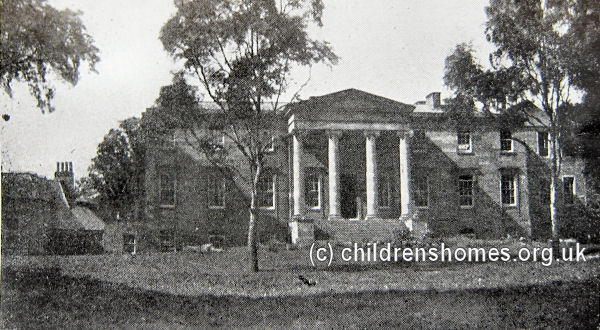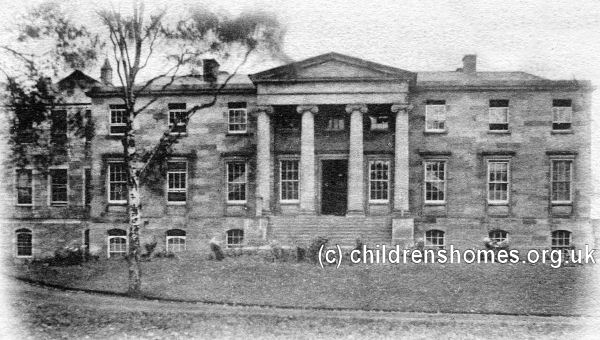St Joseph's Industrial School for Roman Catholic Boys, Tranent, East Lothian, Scotland
St Joseph's Industrial School for Roman Catholic Boys was established in 1889 at Tranent, near Prestonpans, under the auspices of the Roman Catholic Bishop of Edinburgh. It was housed in a large old-fashioned mansion, substantially built, with good grounds and a large garden. The premises were formally certified to operate as an Industrial School on June 22 1889, with accommodation for 50 boys, subsequently increased to 70. The superintendent was Mr D Sullivan and the matron was Mrs Shaw.
An inspection report 1892 noted that some interior alterations had been carried out to provide additional accommodation. The dormitories were said to be well kept and there was a good laundry and plunge bath. The boys' classroom performance was coming on well. As regards industrial training, 14 boys working under a tailor, who came three days a week. A large class worked with the gardener. There was a junior class for knitting and repairing. The boys assisted in the kitchen and laundry, and did all the house-work. The boys were noted as performing drill remarkably well. The superintendent and matron were now Mr and Mrs E. McGee, with Miss Annie McGee as school-mistress. Her younger sister, Miss J. McGee subsequently became assistant teacher.
In April 1894, the School began to make use of the Home for Working Boys at 52 Lauriston Place, Edinburgh. It housed boys who were out on licence from the School and taking up employment in the city.
A large new block was constructed in 1896, providing a schoolroom, dormitory, sickroom, kitchen and officers' rooms. The School's official capacity was increased to 200 places on 10 September 1896. Gardening and tailoring were now the main industrial occupations, with clothes for the inmates being made in the tailor's shops. A drum and fife band had been established, along with a band of pipers. Some of the boys were learning Highland, Irish and other dances. Military and physical drill were carried out and there was a football field at the front of the house. The School's location, in a sparsely populated district, made outside matches difficult to arrange, however. Boys were allowed a visit home once a month. A system of good conduct stripes was in operation, with money rewards. in 1899, mark system was introduced, giving awards for good conduct and work in school.
In 1899, a new workshop was erected in the grounds with a view to training the boys in upholstery.
The School site is shown on the 1907 map below.

St Joseph's Industrial School for Roman Catholic Boys, Tranent, c.1907.

St Joseph's Industrial School for Roman Catholic Boys from the south, c.1900. © Peter Higginbotham
A fine gymnasium was erected in 1902, and the old playroom in the main building converted to a dormitory. A field of 2½ acres had been acquired for football etc. Sixteen matches were played against outside teams. A supply of tents was also secured and the boys camped out for a month in the summer. Magic lantern entertainments were arranged each fortnight. A number of pet birds were kept.
In 1903, the School purchased a fire engine which was also used to clean the windows so as to ensure that the hose was kept in good working order.
The School suffered from an outbreak of a mystery infection in March to June 1904, which recurred the following September. Six boys died and the premises were vacated for six months.
In January 1906, Mr McGee and his family moved to take charge of St John's Reformatory, Walthamstow. He was succeeded as superintendent at Tranent by Mr M.H. Murray, with Miss A.M. Murray as matron, and Miss A.G. Murray as assistant matron. Following Mr McGee's departure, the boys got completely out of control and there was a great deal of absconding. The unrest was made worse by a number of, old boys coming to the school and staying for weekends. The boys' health was also poor, with with cases of conjunctivitis and 17 cases of ringworm being reported. The Murrays departed at the end of November and were replaced by Mr and Mrs John McDonald. Other staff now included the assistant superintendent, Mr P Durkin; schoolmaster, Mr Patrick Murphy; assistant school-master, Mr J. McGettigan; upholsterer, gardener, and tailor. A Pipe Major and a manual instructor attended two or three times a week.

St Joseph's Industrial School for Roman Catholic Boys from the south, c.1908. © Peter Higginbotham
In 1910, a row of six cottages was built for the accommodation of staff. Two new workshops were also erected.
Another bad year for health came in 1911 which was marked by four deaths, 32 cases of trachoma, 19 of conjunctivitis, and another mysterious illness which affected 106 boys.
By 1920, the running of the School had been taken over by De La Salle Brothers. The superintendent in that year was the Rev. Brother Ignatius. In 1930, the Rev. Brother Sylvester was in charge.
In 1933, Tranent became an Approved School, one of the new institutions introduced by the 1933 Children and Young Persons Act to replace the existing system of Reformatories and Industrial Schools. Tranent School, as it was now known, could accommodate up to 150 Junior Boys aged from 7 to 13 years. The superintendent in 1935 was the Rev. Brother Theobald.
In 1943, the school was said to provide a practical training in wood and metal work, tailoring, shoemaking and market gardening. There pipe band was still active. The headmaster was now the Rev. Brother John.
Following Scotland's 1968 Social Work Act, the School was redesignated as a 'List D' School.
The School closed in 1997. In more recent times, the property has been occupied by the Pathway Children's Resource Centre.
Records
Note: many repositories impose a closure period of up to 100 years for records identifying individuals. Before travelling a long distance, always check that the records you want to consult will be available.
- De La Salle Provincialate, 140 Banbury Road, Oxford OX2 7BP.
Bibliography
- Higginbotham, Peter Children's Homes: A History of Institutional Care for Britain's Young (2017, Pen & Sword)
- Mahood, Linda Policing Gender, Class and Family: Britain, 1850-1940 (1995, Univeristy of Alberta Press)
- Prahms, Wendy Newcastle Ragged and Industrial School (2006, The History Press)
Links
Except where indicated, this page () © Peter Higginbotham. Contents may not be reproduced without permission.


